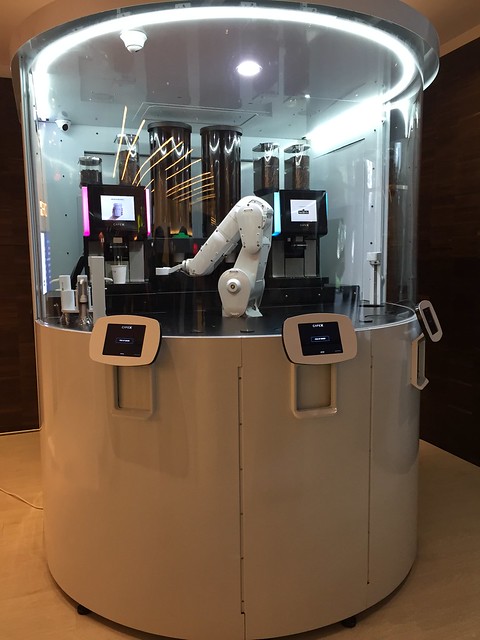
Vending machines capable of making cappuccinos, lattes, and other espresso beverages are nothing new. You may have used one while staying up late at college, or struggling to keep your eyes open during break on jury duty. The espresso they make tends to be mediocre, but it’s better than nothing.
But that’s changing. A startup called Cafe-X has taken the espresso vending machine concept and given it a high tech twist. Since they had one up and running in San Francisco, where I live, I figured I should head over and try it myself.
The machine sits in a corner of the ground floor of the Metreon, a mall complex that also features a Target and a movie theater. A crowd had formed around the machine, which features a big window in the front so you can watch the high-tech “magic” at work. Two Cafe-X employees where on site to answer questions and help customers punch in orders.
A pair of high-end superautomatic machines make espresso drinks, and a robot arm shuffles paper cups between the machines, pumps for syrup, and pick up windows. These machines differ from your standard espresso vending machine in a couple of important ways.
First, the robot arm and multiple espresso machines mean that it can make more than one drink at a time. While it does take up more space than a traditional espresso vending machine, it also means that orders can be streamlined for efficiency to reduce line speed. The completed drinks are placed in a queue by the robot arm until you punch your order code into the tablet, at which time the arm moves your cup into the pickup area.
Second, Cafe-X has focused on quality. They’ve partnered with a number of high end coffee roasters to tweak the machines variable’s to make the best possible espresso out of the roaster’s beans.
I suspect the espresso machines themselves are off-the-shelf products, though their branding had been covered up or removed so I’m not sure which model they’re using. It did make a perfectly good cappuccino, although the foam didn’t have the latte art you’d expect at a good cafe.
But there are reasons to be skeptical that Cafe-X’s machine could truly work without human supervision. One issue that I immediately noticed was the machine sits on a raised platform. Someone in a wheelchair would not be able to get to their coffee without help. I imagine that could be addressed through a new design.
Another issue is that the machine isn’t aware of its surroundings by any means. During my visit, some kind of enormous cockroach wandered over. One of the Cafe-X employees scrambled to get the cockroach into a cup and away from the machine. Vending machines have similar problems, of course. The employee joked to me that he would have prefered if the robot could have dealt with the problem since it wouldn’t have been as afraid of the insect as he was.
So while Cafe-X isn’t the perfect replacement for a cafe, it could be a replacement for your traditional espresso vending machine. While the robot arm is impressive I do have to wonder if it’s truly necessary. In an office setting for example, I don’t think it would be too onerous to ask the employees to place their own cups and pump their own syrups. In a setting like that the only advantage is that Cafe-X dials in the right settings to the machine and maintains them, but it hardly justifies the bulky machine.
Is Cafe-X just a gimmick? Right now, I think the answer is clearly yes. The footprint of the thing is far larger than your average vending machine, and in many situations there’s no benefit to the robot arm. But that doesn’t mean there’s no future in espresso made by robots, it just means that it isn’t here yet. Of course, the next model from Cafe-X could easily prove me wrong.


